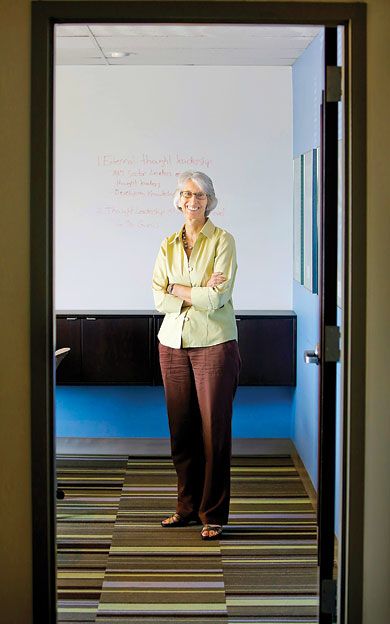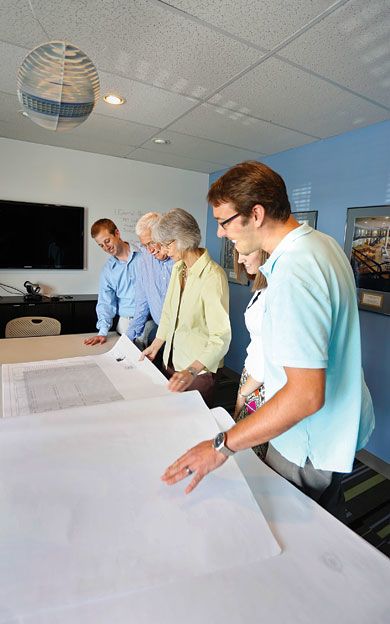Women to watch: Ellen Belknap, SMRT Architects and Engineers
Ellen Belknap didn't think of herself as a pioneer when she started working at SMRT Architects and Engineers in Portland after getting her master's degree in architecture from Columbia University in 1986. Like any graduate, Belknap says she was simply eager to prove herself in her chosen profession. And Portland, given childhood summers spent on nearby Cliff Island, seemed like the right place to start out, especially so since she'd gotten her foot in the door at SMRT with a summer internship in 1983.
But pioneer she was, since less than 5% of certified architects in the United States were women at that time. Even now, according to Architectural Record, only 23% are women. Among architectural leadership teams, just 17% of principals and partners are women.
“I have been very fortunate in the field of architecture that I've never been held back as a woman,” says Belknap, who became SMRT's president 10 years ago. “In terms of the question, 'Is there something about being a woman that informs my leadership style?' I would say, certainly: My work is highly collaborative; the 'care and feeding' of multiple stakeholders matters to me. I've worked hard over the years to improve the people skills of multi-tasking and facilitating large group efforts. I'm often thinking about how to create opportunities for members of the firm to be exposed to different types of clients and challenges, and I get a tremendous amount of professional satisfaction when someone within the firm is clearly growing in the profession.”
Then, with a smile, she quickly adds, “That's not to say men don't have those skills too.”
As president of a $14 million company with 80 employees working in Portland and regional offices in New York and New England, Belknap says her role has shifted from the design work she did in those early years into paying greater attention to functional challenges her clients hope to address with a particular building project. She's the leader of SMRT's health care practice sector, which comprises a third to a half of the company's overall business, building on client relationships that she's developed over more than two decades.
“Where my career has been going is where my clients needed me to go,” she says. “I learn from my clients daily, and they learn from me. It's an exchange that's mutually beneficial.”
Belknap says MaineGeneral Health's new $322 million hospital that opened 10 months ahead of schedule in Augusta last fall is a shining example of how openness and a willingness to collaborate with clients can work to everyone's advantage. She credits Chuck Hays, MaineGeneral's CEO, with raising the idea early in the planning process with SMRT, that the hospital, architect and building contractors use an “integrated project delivery” approach to the project instead of following a more traditional construction management approach.
“You are all at risk together,” Belknap says, explaining that under the IPD approach, the owner, architect and contractors sign a contract waiving any future claims against one other if the project is completed late or goes over budget. “All the parties are aligned to the project's success. It's a way of realigning the energy and chemistry of everyone involved to the common goal of a successful completion of the project. It's a highly collaborative way of working … and it's a lot more fun.”
In the MaineGeneral hospital project, Belknap says, all the parties knew $700,000 in savings would be split among them for every month the project came in under the agreed-upon completion date, with half going to MaineGeneral and the other half being split by the construction-and-design team. More importantly, she says, it facilitated discussions from the very start about how the hospital's design and construction could enhance a patient's health and care experience while also reducing the overall cost.
“It has really hit the mark in terms of fostering a positive experience for patients,” she says of the completed Alfond Center for Health. “All of the patient rooms are private, which is a major advancement that reduces the risk of infection, improves privacy and promotes healing. From each bed you can see out the window to the horizon line. These are all things that can enhance the healing process. If the building can enhance healing, then we've done something as architects.”
The new Augusta hospital also has achieved high benchmarks for energy usage and lower overhead costs, including being the first hospital in Maine and only the second in the nation to be built successfully to the 2010 Leadership in Energy and Environmental Design gold standard for health care set by the U.S. Green Building Council. Annual projections for the hospital estimate it will use 12 million fewer gallons of water and reduce its heating and cooling costs by almost $1 million annually.
More recently, Belknap has focused on the emerging trend of designing “patient-centered” medical office buildings for Martin's Point Health and Mid Coast Health Services, among other clients. In that work, Belknap says she is drawing upon a key lesson learned more than 20 years ago when she was designing a new pediatric wing for Eastern Maine Medical Center in Bangor.
Her preliminary design for the new wing, to be located on the hospital's eighth floor, had received a lukewarm response when it was rolled out in a focus group meeting with parents, staff and young patients. She instinctively felt the design's flaws would become evident to her if she escaped her architect's workstation and did a sleepover at EMMC. She was curious to learn what it was like for sick children to spend a night in the hospital away from home, sometimes without a parent being able to stay at their bedside while they slept.
“I realized what a difficult environment it was for a kid,” she recalls. “A hospital at night can be a noisy, dark and scary place. What kids want is a feeling of security. They want to see other kids playing in the hallway, not nurses coming and going from a workstation … They want to see their moms and dads coming down the hallway.”
She realized the outward focus of her original design — highlighting stunning and sweeping views of the Penobscot River as seen from the pediatric wing's eighth floor location during the daytime — simply didn't work at night. All that beauty became a vast scary darkness outside the window. She realized what an ailing child really wants and needs — both day and night — is an inviting place just outside their hospital room that might help them forget, however briefly, they are in a hospital.
“The wanted an indoor 'backyard' is what they wanted,” Belknap says, describing how she flipped her design's outward focus to create a kind of central playroom, with a lighthouse to play in, an aquarium with ceramic tiles of exotic brightly colored fish and a wall mural painted by Maine artist Dorette Amell featuring clouds with animal shapes hidden within them. Each room also had its own sign — a chipmunk, moose, deer or other animal — to help children find their own hospital beds.
“When the unit opened, Stephen King, who with his wife, Tabitha, was a major donor, said, 'I really like the unit. It's kind of quirky. It's whimsical. It's about the time and place of Maine,'” she says. “That's an early example of evidence-based design. In some ways, this was before its time in terms of the focus on patient-centered care.”
To this day, Belknap says, she draws on the insights she learned from that early project to help her remember a building's function is what drives its form. It also illustrates the wisdom of something her father, a professor of Russian literature, taught her long ago.
“My Dad taught me the value of curiosity,” she says. “The value of engaging with the people around you is really important. What helps me as an architect is being curious about my client's wants and needs. My focus is to understand how to make my clients successful, and that involves asking the right questions so our team can hit on the right response that will help clients achieve their goals … whether it's to increase market share or advance in a new direction.”
DOWNLOAD PDFs
Ellen Belknap, SMRT Architects and Engineers
Read more
Women to watch: Claudia Raessler, Maine Textiles
Women to watch: Lauren Wayne, State Theatre
Women to watch: Amber Lambke, Maine Grains
Women to watch: Margo Walsh, MaineWorks
Women to watch: Claudia Raessler, Maine Textiles
Women to watch: Lauren Wayne, State Theatre
Women to watch: Amber Lambke, Maine Grains













Comments